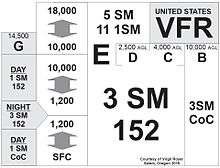Visual meteorological conditions

In aviation, visual meteorological conditions (or VMC) is an aviation flight category in which visual flight rules (VFR) flight is permitted—that is, conditions in which pilots have sufficient visibility to fly the aircraft maintaining visual separation from terrain and other aircraft. They are the opposite of instrument meteorological conditions (IMC). The boundary criteria between IMC and VMC are known as the VMC minima and are defined by: visibility, cloud ceilings (for takeoffs and landings), and cloud clearances.
The exact requirements vary by type of airspace, whether it is day or night (for countries that permit night VFR), and from country to country. Typical visibility requirements vary from one statute mile to five statute miles (many countries define these in metric units as 1,500 m to 8 km). Typical cloud clearance requirements vary from merely remaining clear of clouds to remaining at least one mile away (1,500 m in some countries) from clouds horizontally and 1,000 feet away from clouds vertically. For instance, in Australia, VMC minima outside controlled airspace are clear of cloud with 5,000 m visibility below 3,000 ft AMSL or 1,000 ft AGL (whichever is higher), and 1,000 ft vertical/1,500 m horizontal separation from cloud above these altitudes or in controlled airspace. Above 10,000 ft, 8,000 m visibility is required to maintain VMC. Air traffic control may also issue a "special VFR" clearance to VFR aircraft, to allow departure from a control zone in less than VMC – this reduces the visibility minimum to 1,600 m.
Generally, VMC requires greater visibility and cloud clearance in controlled airspace than in uncontrolled airspace. In uncontrolled airspace there is less risk of a VFR aircraft colliding with an instrument flight rules (IFR) aircraft emerging from a cloud, so aircraft are permitted to fly closer to clouds. An exception to this rule is class B airspace, in which ATC separates VFR traffic from all other traffic (VFR or IFR), which is why in class B airspace lower cloud clearance is permitted.
UK VFR minima
Uncontrolled airspace (class F & G)
At and above FL 100:
- 8 km flight visibility, 1500 m horizontally from cloud, 1000 ft vertically from cloud
Below FL 100:
- 5 km flight visibility, 1500 m horizontally from cloud, 1000 ft vertically from cloud
At or below 3,000 ft:
- 5 km flight visibility, clear of cloud and in sight of the surface
- or, for an aircraft, other than a helicopter, operating at 140 kt or less:
- 1,500 m flight visibility, clear of cloud and in sight of the surface
- For helicopters:
- Clear of cloud and in sight of the surface at a speed with is commensurate with the visibility.
Controlled airspace (classes C to E) By Day
At and above FL 100:
- 8 km flight visibility, 1,500 m horizontally from cloud, 1,000 ft vertically from cloud
Below FL 100:
- 5 km flight visibility, 1,500 m horizontally from cloud, 1,000 ft vertically from cloud
Alternatively at or below 3,000 and operating at 140kt or less ft:
- For fixed-wing aircraft:
- Clear of cloud and in sight of surface with a flight visibility of 5000m
- For helicopters:
- Clear of cloud and in sight of surface with a flight visibility of 1500m
Controlled airspace (classes C to E) By Night
At and above FL 100:
- 8 km flight visibility, 1,500 m horizontally from cloud, 1,000 ft vertically from cloud
Below FL 100:
- 5 km flight visibility, 1,500 m horizontally from cloud, 1,000 ft vertically from cloud
US weather minima
Class G airspace
Surface to 1200 feet AGL (Above Ground Level):
Day: 1 statute mile visibility, clear of clouds (except as provided for in §91.155, paragraph (b))
Night: 3 statute miles, 500 feet below, 1000 feet above, and 2000 feet horizontally from clouds (except as provided for in §91.155, paragraph (b))
1200 feet AGL to 10,000 feet MSL (Mean Sea Level):
Day: 1 statute mile visibility, 500 feet below, 1000 feet above, and 2000 feet horizontally from clouds (except as provided for in §91.155, paragraph (b))
Night: 3 statute miles, 500 feet below, 1000 feet above, and 2000 feet horizontally from clouds (except as provided for in §91.155, paragraph (b))
1200 feet AGL and above 10,000 feet MSL:
Day or Night: 5 statute miles, 1000 feet below, 1000 feet above, and 1 statute mile horizontally from clouds (except as provided for in §91.155, paragraph (b))
Class E airspace
At or above 10,000 ft MSL:
- 5 statute miles visibility, 1 statute mile horizontally from clouds, 1,000 ft above and below clouds
Below 10,000 ft MSL
- 3 statute miles visibility, 2000 ft horizontally from clouds, 1,000 ft above and 500 ft below clouds
Class C and D airspace
At any altitude:
- 3 statute miles visibility, 2,000 ft horizontally from clouds, 1,000 ft above and 500 ft below clouds
Class B airspace
- 3 statute miles visibility, clear of clouds
Class A airspace
- VFR flight prohibited in Class A airspace.
You must be instrument rated, have an IFR flight plan, 2-way radios, and a Mode-C Transponder
See also
References
- ↑ http:www.caa.co.uk/cap493
- ↑ http://www.caa.co.uk/cap493
External links
- U.S. Federal Aviation Regulations defining visual meteorological conditions.
- Guide to Visual Flight Rules in the UK